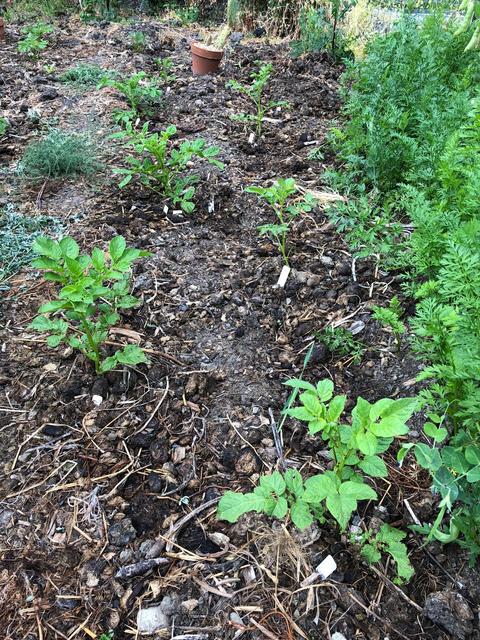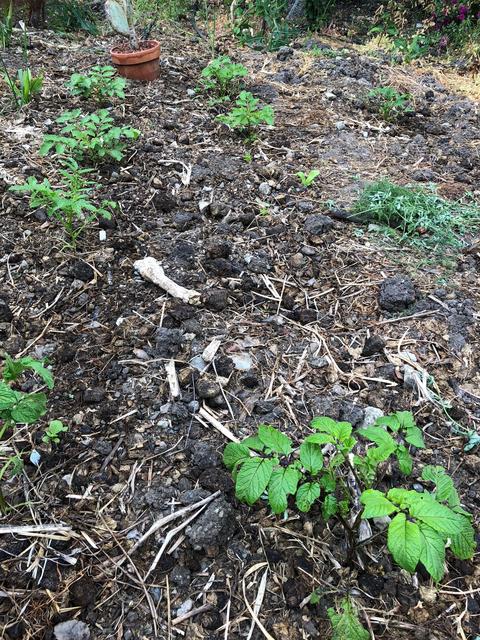|
|
Post by fliver on Nov 23, 2017 8:42:00 GMT -5
What would be the best way to cross them? Plant them among each other and let nature do it's thing, or get out the tweezers and do it manually? Or both?
|
|
|
|
Post by billw on Nov 23, 2017 13:10:17 GMT -5
Assuming that you have a healthy bumblebee population, interplanting them should be sufficient. I would alternate phureja and stenotomum in a big block. Because they will mostly be short day, you should have a long period of flowering, with plenty of opportunity for crossing. Typically, phureja types have nicer colors and flavors, while stenotomum has more interesting shapes and better dormancy, so you can get great stuff from the crosses. If you then take the best of the progeny and try crossing them to tetraploids, you can introduce some of those characteristics. You will find that roughly 1 in 10 varieties are able to pollinate tetraploids with a reasonable degree of success.
|
|
|
|
Post by nathanp on Nov 24, 2017 0:00:43 GMT -5
The Ars-Grin database is not as easy to search as it used to be before they lumped all the phureja, stenotonum and andigenum tubers all under andigenum. However, many of the accession pages still show the previous designation. It would be nice to be able to search that way.  I find that working with diploids is more difficult that most tetraploids for the reasons that Bill mentions. Most of them have not been adapted for the long day lengths of the summer at high latitudes, so they do not set tubers until days get shorter in September. Or they have the low dormancy issues. Those traits may also be true of andigena tetraploids, but you won't find many of those available in the US unless you receive them from the USDA or hobby breeders. The genepool of available tetraploids is much, much higher that that of diploids. With regard to diploids tuberizing, usually the yields are lower than for tetraploids, but you may find lines or crosses that are an exception. I find that I only save about half as many diploids to be regrown, compared to tetraploids, when I am growing out TPS seedlings. It may even be lower than that. I've been meaning to calculate that out at some point. |
|
|
|
Post by keen101 (Biolumo / Andrew B.) on Nov 24, 2017 1:40:29 GMT -5
mine failed mostly because it was my first time working with it. Failed to germinate many plants. Then the ones i planted failed to thrive. Maybe just a bad spot. Just need to try again.
|
|
|
|
Post by nathanp on Nov 24, 2017 10:57:23 GMT -5
mine failed mostly because it was my first time working with it. Failed to germinate many plants. Then the ones i planted failed to thrive. Maybe just a bad spot. Just need to try again. I find germination rates with TPS vary quite a bit depending on age of seed and variety. Average is probably 60-65% for me, and I do not use anything to break down the germination inhibitors that coat TPS in it's first few years. Some varieties germinate at or close to 100%, though usually only after 2 years from removing from the berries. Others are very low. I have found some as low as 0-4%. Most are in the 50-90% range, and I'd bet it would show as a bell curve if I were to graph that, but that's just anecdotal at this point There are some things you could do to increase that if you needed to have a higher percentage. I generally just plan to start germinating extra TPS from the start. Usually 1.5-2 times what I want to end up with, and I select the best of those that germinate to transplant. After doing this for a number of years, I've gone through the gamut from trying to baby and save every single seedling, to realizing most of those that struggle probably don't end up being worth growing (for low yield, poor disease resistance, lack of vigor, etc.). Unless it is something rare that I want to save the genetics from. Otherwise, if you want to get ones that grow well in your location, with whatever growing methods you use ... selection, selection, selection is probably best to eliminate those not suited for that. Unfortunately for me, I find my growing season is not quite long enough to suit most diploids well. I grow some, and there are some lines I will keep working with, but it's probably a much smaller group than what Bill or others in the Pacific NW can work with. It's also probably a larger group than what some in colder climates can work with. I am in zone 6b/7a coastal New England. ~150 days where I grow my tubers, and about 2 weeks longer at my home garden where I grow my TPS. |
|
|
|
Post by farmermike on May 27, 2018 15:49:28 GMT -5
fliver, thanks for sharing some of your diploid seed with me this winter! Are you having any luck getting this project started? I planted exactly 6 seeds of each of the 6 varieties you sent (3 phureja, 3 stenotomum). I got at least 3 or 4 plants of each variety to work with. I'm pretty happy with that! 225668 Careta Amarilla (right side) had the best germination and vigor, 225705 Rosalena had the worst (middle). Photo: April 20th 2018  I still eventually potted up those 3 seedlings in the middle, and they seem to be catching up very slowly. I may grow them in a pot where I can baby them rather than in the field. Here are my little diploid potato patches on May 25th. They have been in the ground for about a month now. High dormancy (stenotomum) diploids seem to be doing pretty well.  The low dormancy (phureja) varieties are mostly doing well, but you can see a couple of gaps in this photo. A few plants were immediately eaten to the ground by some insect while they were still small and weak. The rest were totally untouched. I suspect some kind of caterpillar, but I never saw them. I did find one little green (inchworm) caterpillar eating potato leaves far away from this location. I have a few more backup plants to fill these gaps.  I'm excited to see what comes of these diploids. I'll be particularly happy if they produce some berries. The fact that they may have a long flowering period should help with this. I get a lot of hot weather here, which makes it hard to get potato fruit, but we also get some nice stretches of cool weather, so more flowering may help to get the timing right. Also, low dormancy may not be the worst thing with my long growing season and mild CA winter. I often can have fall plantings of potatoes that stay green through the winter if they have some protection next to a building or a large cactus. So, I have a couple of questions for the experts! 1) Are these diploids likely to have any variability for frost tolerance that I could select for? 2) Since these are day-legnth sensitive, and and only form tubers during less than 12 hour days, what would they do if I manage to grow them over winter? Our days are less then 12 hours between Sept. 25th and March 16th. Would they be able to form tubers during any of that period, or does it have to actually be around 12 hours? fliver, if I get any seed from these, I'll be happy to send some back to you. Tubers too, though I'm not sure I'd know how to ship them.
|
|
|
|
Post by billw on May 27, 2018 16:00:35 GMT -5
The high dormancy diploids are more likely to have frost tolerance and the low dormancy diploids more likely to have heat tolerance. They ought to tuberize any time the day length is less than 12 hours. The high dormancy diploids often have some longer photoperiod types.
|
|
|
|
Post by fliver on May 28, 2018 10:49:21 GMT -5
I had a bit of a setback. My father passed away on 6 April. Those sorts of things have a way of taking the wind out of your sails and redirecting your attention elsewhere. As a result my tps seedlings died of neglect. I have subsequently replanted them and many of them have germinated and are waiting to be transplanted when they get a little bigger.
|
|
|
|
Post by philagardener on May 28, 2018 12:43:13 GMT -5
I had a bit of a setback. My father passed away on 6 April. Those sorts of things have a way of taking the wind out of your sails and redirecting your attention elsewhere. As a result my tps seedlings died of neglect. I have subsequently replanted them and many of them have germinated and are waiting to be transplanted when they get a little bigger. Sorry to hear of your loss but glad to hear you are growing again. Seeing seedlings pop up and spread their leaves reminds us that life runs in cycles. |
|
|
|
Post by fliver on May 28, 2018 15:17:31 GMT -5
fliver , if I get any seed from these, I'll be happy to send some back to you. Tubers too, though I'm not sure I'd know how to ship them. I am always up for seed swap, both ways. Tubers might be a little tricky. I'm glad your tps are growing so well. The largest plant I have is about 1 inch tall. |
|
|
|
Post by fliver on May 28, 2018 15:22:00 GMT -5
Thanks philagardener, plants and my children always give my life meaning.
|
|